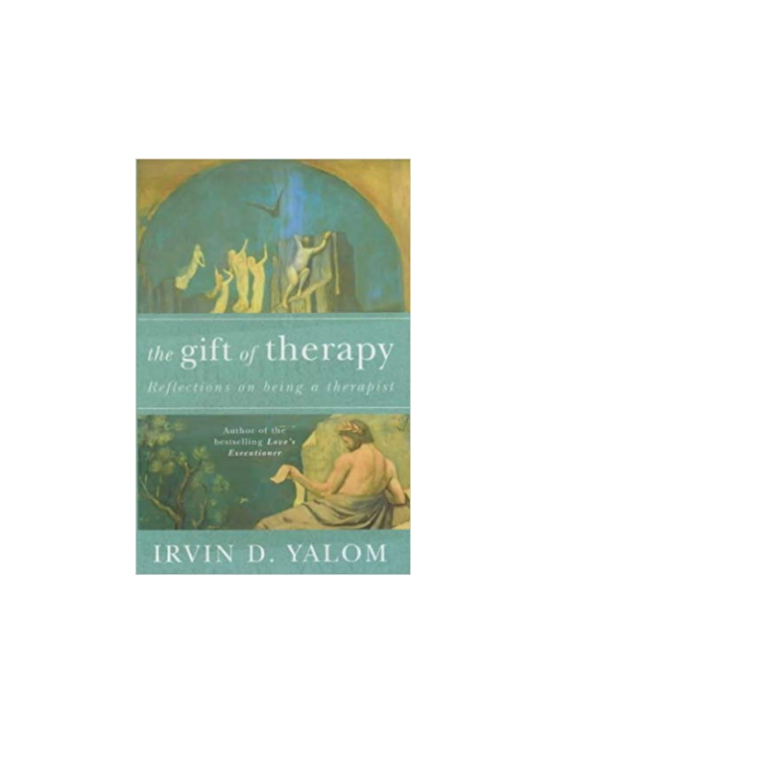The following piece is a short, personal, reflection on The Gift of Therapy: Reflections on being a therapist by Irvin D. Yalom, as written by ICPPD Year 2 Learner, Bríd Kennedy, Chartered Psychol Ps.S.I.
The Human Encounter in the therapeutic process (p. 220)
Yalom’s book is a deceptively simple narrative with enormously important and complex content. He
evokes his experiences with clients, through lots of examples, stories, apt references and quotations
from other philosophers and therapists, He generously shares the skilled therapeutic wording he uses
with clients with humility and honesty. While he makes therapy seem doable, his vast talent, quick
intellect spots the patterns and opportunities in therapy sessions, and gives them voice gently and
with great empathy and compassion. I feel humbled reading this book, there is so much to learn, and
experience as a therapist. Every encounter is learning, and grist to the mill of becoming more
effective.
1-40 The therapist – patient relationship
Rather than taking on a client’s huge existential problem, the therapist’s job is to identify and remove
the obstacles, one by one with the client that are blocking her/him. Within this I noticed that Yalom
talks of ‘we’ wresting with ‘each obstacle in turn’. Reminded me of a Jack Welsh YouTube clip I saw
recently, comparing in his case, leadership, to the job of the sweeper in curling, where the ice is
smoothed out so that the sportsperson can perform their sport, and above all the collaborative
approach that underpins Yalom’s therapy.
He warns about the pitfall of diagnosis which distorts the process, how the therapist might be
constrained by stereotypes, and indeed may serve to accentuate the stereotyping. This reminded me
of self-stigma, and how that can be an obstacle too, needing attention, and collaborative work.
What strikes me a lot in the book is the emphasis on therapist and client collaborating as equals, the
awareness and deconstruction of the power relationship, as he puts it – we are ‘fellow travellers’ in
the human journey. I can identify with the notion of the wounded healer. Yalom teaches through
stories like Hesse’s Joseph and Dion story, which is very moving, there is great wisdom in staying with
the questions, as he says ‘try to love the questions’ – like the common phrase – it’s better to travel
than to arrive – not so much the answering of questions or the solving of the problems, rather it is the
questions and quest themselves.
He clearly says that one of the main problems that clients carry is their fear of intimacy – a sense that
there is something inherently flawed in them, and that this (as with all interpersonal problems)
emerges in the relationship between therapist and client quickly and clearly. He emphasises
throughout the here and now (‘Use it, use it, use it!’ Ch. 14) in the current relationship – ‘How are we
doing today?’ he gives excellent questions to explore that space. He also highlights the importance of
tending to the silence – what is unspoken- with a client. Yalom finds equivalents in the Here and Now
for the presenting issues – and advocates that they are better dealt with, as they are teachers for the
client. There is no need for the therapist to draw the analogy, as the process is where the learning
takes place. Here- and – now approach may include references to past sessions. All therapist
comments are sensitive and empathic, couched on the best interests of the client.
His examples of times when he compared notes of sessions with clients’ notes are very enlightening –
reminds me of teacher role, where one might have a great sense of accomplishment, everything going
to plan, and the student experience being entirely and absolutely different. A humble space.
He reminds me of the great acts of courage for clients, as they bravely set about change, and that the
therapist supports them in every way – even to commenting on appearance. At the same time, he is
encouraging to the learner therapist with his story of the guru and his unconfident student ‘I see no
imperfections’.
Empathy – being open to looking out their window is well illustrated, and he instructs that one checks
assumptions during feedback, and grasps direct comments from the client (Is there a question in there
for me?’) Everything in therapy is grist for the mill.
At the same time, he has a lovely phrase – strike when the iron is cold – returning to high emotions
when they have subsided – perhaps next session –
The therapeutic relationship is as significant for the therapist as for the client, Yalom urges one to let
the clients matter to you. He also suggests that therapist disclosure assists with client disclosure, and
that it is important to be authentic. Acknowledging one’s own errors matters and encouraging clients
to help you see your own blind spots- so that this is genuine and authentic collaboration – all the time
retaining focus on the client. At the same time later, he urges caution around self-disclosure so that
focus remains on client – e.g. asking ‘Why you ask me that?’ – is helpful. Being authentic is significant
to clients – the genuineness of the process is important. He distinguishes between vertical (in depth)
and horizontal (disclosure around disclosure – what made it possible for you to talk about this today?).
The Johari window reminded me of work I have done before.
Dealing with uncomfortable disclosure or aspects for the client, he suggested using ‘parts’ – I think
this is very useful, as it allows the client to look at parts of themselves, knowing that this is just a part,
and not their entirety.
He sees every client-therapist relationship as new. He seems to reject manualised approaches (like in
earlier or computerised CBT). He wants to avoid formulaic, protocol driven approaches. His sessions
appear to have the pattern of the experience, and then the examination of that experience. This seems
to challenge brief therapy approaches.
I was a bitshocked when he said that he once instructed a client not to go to his father’s funeral, albeit
with reason – I suppose culturally, or in my own understanding of our culture, that would be e big nono,
to interfere with a cultural, family event. I probably need to examine these ‘fixed’ ideas in my own
attitudes to death.
He emphasises the importance of engaging in personal therapy, and to be aware of all the tendencies
therein, so as to develop awareness and inner strength for psychotherapeutic work, as well as of the
diversity of possible approaches. Also the importance of group process experiences. He says the
therapist has many clients, but the client only has one therapist – it seems obvious, but his point is
clear – therapy is important for the client, and the therapist remembers this.
The reference to age states resonated with me, as I think we move around a lot in these – sometimes
child, sometimes, ancient, sometimes 21 and all in between. This is a useful ‘hook’ into someone’s
experience, and enabling for the client. It is also a kind of ‘parts’ approach.
41-51 From process to content
I was interested in Yalom’s approach to the existential dilemma of death – and the importance of
talking about it directly in therapy. Also his exploration in chapter 44 around life’s meaning inevitably
resonated. I wrote two new epigraphs – one positive and one negative – and thought about the effects
of each, (I prefer the positive one of course!) and yet again realised the importance of carving one’s
own destiny.
His phrase ‘So many fixed family rules’ also stopped me in my tracks, time to think of these in my own
family, as well as family of origin. Helping clients see themselves more objectively – even describing
them to themselves as someone else also helps their process of growth.
52-76 Issues arising in everyday conduct of therapy
Sessions flow from one to the next. Notes help you refresh for the next session. I am interested to
learn about note taking and data keeping/protection on the course.
Encourage the client to self-monitor – reminds me of my own struggles with weight loss – my latest
Judith Beck book urges welcoming every aspect, including failures, as opportunities to learn and
develop.
Weeping for clients – I like his approach – ‘What was it like to weep in my presence?’ Benefit emerges
for the client.
The sense of being stuck, or that the client’s storytelling is pushing one away is better named and dealt
with.
He spoke of home visits – and how deeply helpful that can be for the therapist – is this recommended?
I worked for a while as home-school liaison teacher, and visited some homes. It is mostly a great
experience, however, however, once I was in personal danger – I do not know what is recommended
here, and look forward to finding out.
Advancing the relationship with clients was interesting.
I was fascinated by the sections around touch. I wonder what is the advice for therapists now?
Especially around sexual assault allegations? (I have worked around Child Sexual Assault with teachers
and schools, so this is an aspect of therapy, and recommended good practice I am interested in –
among others.)
Anniversary reaction, birthdays, retirements (I’m just retiring!) can be helpful grist to the therapy mill.
Personally, I can attest to retirement being a time of increased contemplation on life -past future and
present, and its meaning and value.
Equally client anxiety before, during or after therapy is important to explore. It reminded me of
previous learning (personally and professionally) where the client is watchful of the impact of their
disclosures on the therapist, and is taking care of them! Again, Yalom had useful examples and
suggestions. Self-soothing – where the client comes up with the words for the therapist that will
soothe them.
He is very honest in expressing his discomfort in working with people in love – something to do with
transience, with the state rather than the object of love; what do the clients in love want in therapy?
People only seek therapy when there is something dysfunctional. Also, release from relationships is
hard slow work. What is the obsession doing for the client? He suggests that obsession serves as a
distraction from more painful thoughts. Ultimately – ‘what would you be thinking of if you were not
obsessed with…? (Ch. 69)’. Yalom again provides wording for a crucial question.
Taking a history – I like his comment – is the same as making history. He asks about the detail of clients’
typical days- good for intimacy building in therapist-client relationship. Finding out about the people
in a client’s life. Even interviewing significant others is useful – again, he provides sensitive and
appropriate wording to facilitate this. (Not couple’s therapy).
Previous therapy is useful. Also validation of client’s darker feelings – we share these, in our common
humanity.
Yalom and CBT: Empirically Validated Therapy (EVT) (a new acronym for me!) He makes the point
clearly that non validated therapies are not invalidated.
77-83 Uses of dreams in therapy
Use them, use them, use them! He sets great store by dreams, and their colossal potential in therapy.
This surprises me initially. My rational mind says – really? Surely the everyday gives us plenty of
strange and distorted material we can work with? Yet, in what I have read in psychotic states, the
tendency in therapy now is to explore these hallucinations/psychotic experiences, and to find
meaning, with the underlying thesis that indeed they have meaning and help healing. (My cynical side
wonders – ‘But is this like Rorschach’s inkblot test?’ Lots of clinical examples helped me understand
that the dreams are useful for therapeutic use – often selective parts. Again, Yalom provided some
basic skills for the therapist – client keeps a notepad by the bed to jot down dreams/fragments.
Therapist takes notes of dream narratives- too complex to trust to chance; client to repeat dream in
the present tense and some useful questions for the client p236. Evoked Perl’s’ deeply symbolic
interpretive work with clients. (Must check all this out! Such an adventure!)
84-85 Hazards and risks of being a therapist
Here again, Yalom generously shares his experience – therapists work in isolation, despite the intimacy
of client-therapist relationships – these are no substitute for deep, personal loving relationships. He
mentions two catastrophes – client suicide and malpractice litigation. Again, he offers practical
suggestions – advocating peer therapy/supervision sessions. He finishes by describing the
extraordinary privilege of therapeutic work, and advocates cherishing this privilege.
Yalom’s book was an excellent suggestion as an introductory for me to the course. I really appreciate
having read it, and look forward to the adventure, challenge and joy of the next two years.
The above article is published with kind permission from Bríd Kennedy
Photos copyright: (https://aviaryrecoverycenter.com; https://www.learnmindpower.com/article/dreams-part-ii/; )










